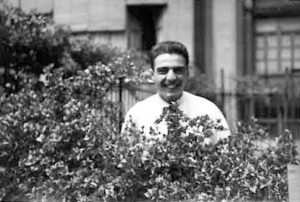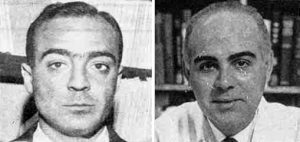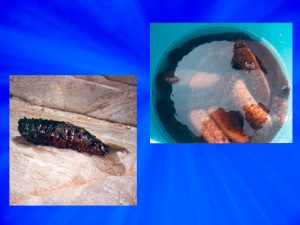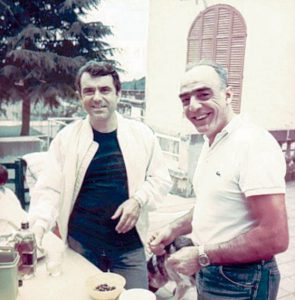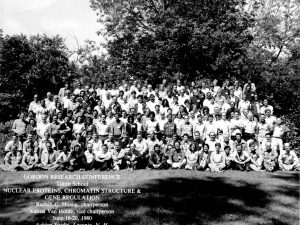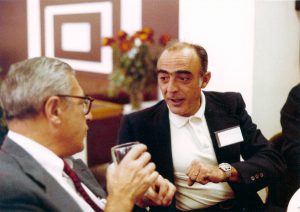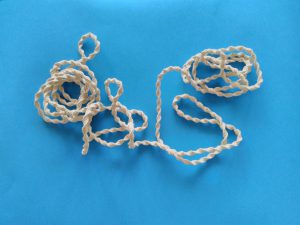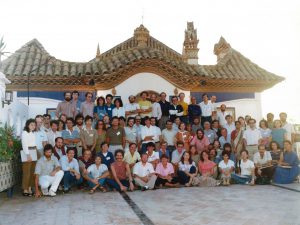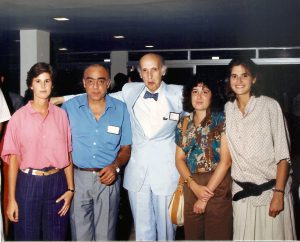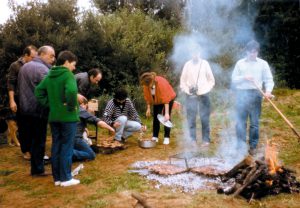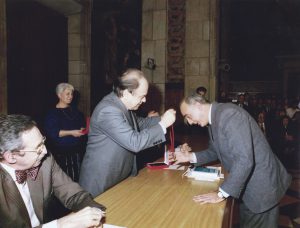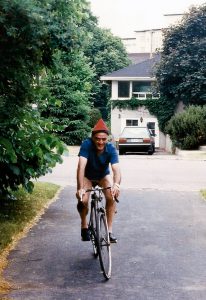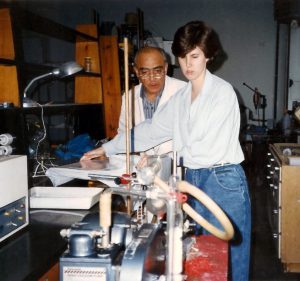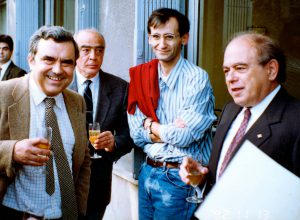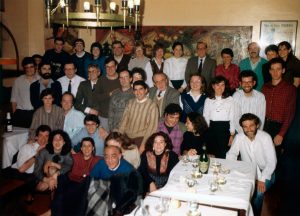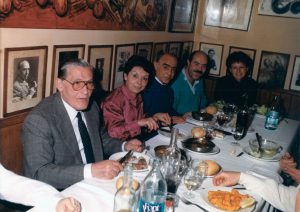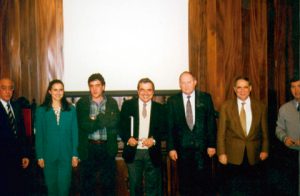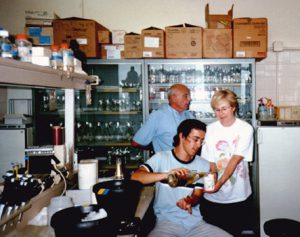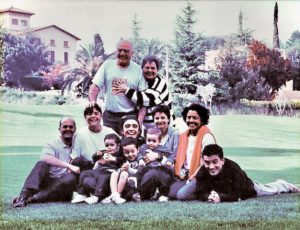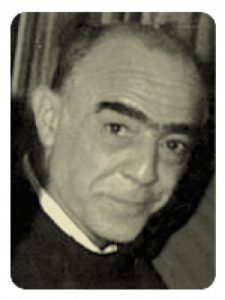
His father Josep Cornudella was born in 1895 in Juneda (Lleida) and he graduated in Medicine in Barcelona in 1919. He was part of the team that opened the Hospital de la Santa Creu i Sant Pau in 1920. There he held different positions and with the passing of the years he was called director of the General Respiratory Apparatus Service. In 1953 he was elected President of the Faculty Body. In 1965 a National Tribute was dedicated to him for having been one of the main promoters of Pneumology in Spain. He died in Barcelona in 1985 at the age of 90 years.
Lluís Cornudella’s mother, Núria Mir Servat, was born in 1903. In 1926 she married Dr. Josep Cornudella, whom she met when he took care of her little sister who contracted typhoid fevers. Later, Núria Mir inherited from her parents an extensive family estate “El Regadío de Can Mir” in Sant Vicenç de Montalt. It is precisely in this place where the Cornudella-Mir family settled during the Spanish Civil War. This farm would later become a frequent meeting point of Lluís Cornudella with his collaborators.
After the Civil War, Lluís Cornudella studied primary and high school in the Jesuitas. He wanted to study medicine as his father, but due to family pressure he ended up studying for a degree in Chemical Sciences at the University of Barcelona. In 1962 he married Natàlia Quintana, a classmate at the University. After graduating Natàlia worked in different jobs and always supported her husband in his research work. They had three children: Sílvia (1964), Mònica (1966) and Carles (1967).
At the end of the degree Lluís Cornudella worked for a few years in a pharmaceutical company. At the same time, he obtained a doctorate in biochemistry at the University of Barcelona, under the direction of Dr. Fernando Calvet Prats. He presented his thesis in 1968 with the title “Los hemicromos de la alfa-quimotripsina, de la tripsina y de la ovoalbúmina desnaturalizadas”. Part of his work with Dr. Calvet was published in the journal Revista Española de Fisiología in 1968 and 1969. His thesis work received the August Pi i Sunyer award from the Institute for Catalan Studies (IEC). In 1969 he participated in the 6th International Congress of the Federación Europea de Sociedades de Bioquímica (FEBS), accompanied by his wife Natàlia. He then worked for a few months in the Department of Macromolecular Chemistry (DQM), a coordinated center of the Consejo Superior de Investigaciones Científicas (CSIC) and the Polytechnic University of Catalonia, located in the building of the School of Industrial Engineering of Barcelona. Later, thanks to a grant from Fundación Juan March, he moved to the United States, where he joined the Laboratory of Cell Biology of the New York Blood Center (NYBC). Several publications on messenger RNA and its binding to cytoplasmic membranes in tumor cells emerged from his work as a researcher at NYBC. From this period, we can highlight the work “mRNA nuclear particles & their attachment to cytoplasmic membranes in Krebs tumor cells”, published in Nature New Biology 233: 234-237 (1971).
In 1972 he returned to Spain and joined the DQM again, being appointed scientific collaborator of the CSIC in 1973. His scientific work focused on the study of chromatin, especially the link between its structural organization and functional activity. It was precisely in 1973 and 1974 when the works that were published showed that chromatin was organized in a regular and repetitive way in substructures called nucleosomes, separated by a spacer DNA zone (see summary in L. Cornudella, Investigación y Ciencia 22: 44-53, 1978). Nucleosomes and their multimers could be released by enzymatic digestion with nucleases. The spacer part was variable in chromatins of different species and was presumably associated with histone H1 and its variants. Most of these studies were conducted on somatic cell chromatin and little was known about active chromatin in transcription.
In order to examine this question, at the end of 1974 Dr. Cornudella began a series of studies on the chromatin of the germ cells of the sea cucumber, Holothuria tubulosa, a subject to which he would devote himself for many years. The spermatogenesis in this echinoderm is quite simple, and presents an appreciable synchrony in the germination maturation stages in all the individuals of the same population. Furthermore, the protein complement of histones is conserved in the sperm at the end of germinal maturation and is not replaced by protamines. The only observed protein transitions are the appearance of H1 variants specific to this sperm, and a small protein, phi-0, rich in arginine.
In a first stage, the action of nucleases on chromatin during the germ cycle was studied, the resulting subunits and their nucleoprotein components were characterized. This study revealed a variation in the enzymatic access to chromatin during germination maturation, showing an initial presence of subnucleosomes that disappeared in the final stages of spermatogenesis: nucleosomes and their multimeric units were the exclusive products of nuclease digestion micrococcal in these final stages. These results indicated possible conformational changes so that the regions where the subnucleosomal particles originated became inaccessible to the enzymes. Simultaneously, the appearance of the phi-0 protein was observed, the proportion of which increased significantly in sperm. It was postulated that the presence of this protein in combination with the sperm-specific H1 variant could modify the access of enzymes to DNA without altering the periodicity in the distribution of nucleosomes. From this work a doctoral thesis and several publications emerged (Biochemistry 18: 3724-32, 1979 and others). At this time, and in recognition of his scientific career, he was awarded in 1977 the gold medal of the Science section in the 9th International Competition of the International Academy of Lutèce (Paris, France).
From 1979 to 1981, he obtained a new grant to carry out a sabbatical period at the Lindsley F. Kimball Research Institute in New York, focusing on the study of the nuclear matrix. His contribution to this topic has been twofold. On the one hand, it consisted of the elaboration of a procedure for the exhaustive enzymatic digestion of nuclear DNA under physiological conditions such that the endowment of histones is retained by the matrix. On the other hand, a method for the purification of hnRNA from the matrix was developed, omitting the use of energetic organic agents such as phenol to avoid the induction of artifactual aggregates by these reagents.
Shortly after returning to Barcelona, in 1982, he presented a work to the Royal Academy of Medicine of Barcelona entitled “Reflexiones sobre la Biología Molecular”, presented by his father Dr. Josep Cornudella, Numerary Academician. At this time, it was incorporated again into the DQM, continuing the characterization of chromatin in the sperm cells of Holothuria tubulosa and other marine invertebrates. With the intention of isolating, sequencing, and characterizing the phi-0 gene, encoding one of the proteins that make up chromatin, a cDNA library and a complete genome library of echinoderm Holothuria tubulosa were built in 1987. This was the first genomic library built in Catalonia. Thus Dr. Cornudella was a pioneer in the construction of genomic libraries.
During the analysis of the genome of the echinoderm Holothuria tubulosa, with the intention of achieving the most efficient fragmentation for the construction of the library, different enzymatic digestions were performed that allowed detecting a fragmentation pattern in scale, corresponding to the presence of a highly repetitive sequence in its sperm DNA. The monomer unit, which was organized in tandem repeats, was cloned and sequenced, determining its proportion and distribution in the genome.
After the discovery of this repetitive element in Holoturia tubulosa, the genomes of several species of echinoderms were analyzed to characterize the possible presence of repetitive homologous elements. A proximal but not identical repeated sequence was identified in a related holothuria, H. polii. Their detailed study and interspecific sequence homologies suggested conservative evolutionary trends. Later, another highly repeated sequence was found in the sperm DNA of the common mussel, Mytilus edulis.
In 1987 he received the Narcís Monturiol medal for Scientific and Technological Merit from the Government of Catalonia. In 1991 he was named Scientific Investigator of the CSIC. This same year he moved to the Department of Molecular Biology of Barcelona and Cellular of the CSIC, where he continued with his two main objectives. The first, to evaluate the biological significance of the diversity of basic nucleoproteins during the spermatogenesis of marine invertebrates, deepening the study of the genes that encode these nucleoproteins and their genomic organization. Among other contributions, the first characterization of a histone H1 gene in mollusks stands out, as well as the finding of gene clusters containing tandems of H1 genes alone, in contrast to what happens in most eukaryotic organisms, where the genes of Histones are organized in clusters containing multiple copies of genes from the 5 classes of histones. The second objective was to delve into the molecular characterization of repetitive DNA species and their structural organization in marine invertebrate genomes, studying their contents, frequencies, location and dispersion patterns as an approximation in the evolutionary trends of distribution of repetitive DNA domains. Several collaborative works were carried out in this area with Dr. Plohl’s group (Zagreb, Croatia); the detection, cloning and telomeric localization of a DNA fragment containing a tandem of the hexanucleotide considered until then the exclusive structural element of the telomeres of vertebrate chromosomes to the Donax trunculus mollusc.
At the same time, his extensive knowledge, his scientific curiosity, his mastery of recombinant molecular biology techniques and, above all, his temperament opened the door for him to establish collaborations with research groups from very different fields that requested his cooperation.
Thus, with researchers from the Department of Chemical Engineering of the Autonomous University of Barcelona, a collaboration project began in 1997 aimed at improving the productive capacity of animal cells in in vitro cultures by genetically modifying cells by inducing overexpression of apoptosis protective genes or others coding for caspase suppressor proteins, inducers of programmed cell death. This collaboration lasted over the years and resulted in various publications, presentations at congresses, doctoral and master’s theses.
On the other hand, the collaboration requested by researchers from the Physical Anthropology Section of the University of Barcelona allowed the introduction of recombinant DNA technologies in the field of Paleoanthropology, carrying out the first genetic analysis of bone remains of up to 5,000 years old from aboriginal populations extinct from Tierra del Fuego and Patagonia. This study established the presence of different migratory waves in the population of the American continent, through the lack of detection in the Paleoindians of two of the four current Amerindian haplotypes, thus calling into question the original hypothesis that the settlement of the New World was the result of a single migratory wave coming from the Asian populations.
Throughout his professional career he demonstrated a remarkable organizational and leadership capacity in his research group; He was very rigorous in keeping the laboratory very neat so that all tools were ready to work effectively. His colleagues remember him as a gentle person and willing to help anyone who needed it, always with a very characteristic sense of humor. As a result of his scientific and teaching activity, he directed six doctoral theses and fifteen final degree projects, dissertations or master’s degrees. As a teacher he was in charge of several postgraduate courses. He published more than eighty scientific works, including various outreach works in the Spanish version of Scientific American, participating in various collective publications, many times as their editor. He was a member of the Spanish Biochemical Society (SEBBM). He also actively participated from the beginning in the activities of the renewed the Catalan Society for Biology (SCB), holding various positions of responsibility, thus contributing to the development of Catalan culture.
On the whole, his scientific work allowed us to better understand the genomes of marine invertebrates and their gene expression throughout spermatogenesis, the genes that encode basic nuclear sperm proteins, and the organization and conformational variability of chromatin during germ cell development.
Acknowledgements
Eva Prats, Elisabet Rocha, Jesús Sainz, Lourdes Campos and Juan Antonio Subirana have contributed to this biographical review, all of them collaborators at some point with Dr. Lluís Cornudella. His relatives have also provided important data and have reviewed this biographical note.

